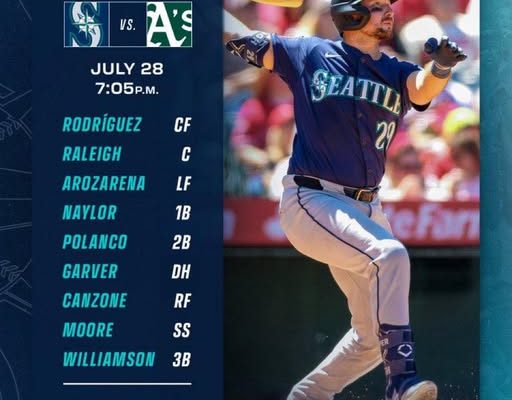The Seattle Mariners are rolling into their matchup against the Oakland Athletics with a noticeably restructured lineup, a tactical decision that speaks volumes about both the urgency of their current standing and the adaptability of their roster. As the season wears on and every game begins to carry heightened postseason implications, the Mariners’ management is clearly pulling every strategic lever available to them. The top of the batting order now looks dramatically different, with Julio Rodriguez moving into the leadoff role, a shake-up that seems aimed at jumpstarting the offense from the first pitch. For a player known more for his middle-of-the-lineup power and presence, Rodriguez’s new spot at the top is both a statement and a gamble.
The move isn’t entirely out of character for Julio Rodriguez. He brings a rare combination of speed, bat control, and game-changing ability that could energize the Mariners in ways not typically expected of a leadoff hitter. His career numbers indicate he’s dangerous early in counts and thrives with a clear mind at the plate, which might actually suit the psychological rhythm of leading off. His presence in the top spot also puts immediate pressure on opposing pitchers, who now have to face a potential All-Star caliber bat right out of the gate. For Seattle, it may also be a message to Rodriguez himself: be the spark. The Mariners’ offense has struggled with consistency at times this season, and giving their most dynamic player more at-bats is a calculated risk that could pay dividends in both the short and long term.
Behind him, Cal Raleigh now steps into the second spot in the order. While traditionally a power-hitting catcher who often finds himself in the five or six-hole, Raleigh’s move up could be an effort to better capitalize on his growing plate discipline and ability to drive the ball to all fields. The Mariners clearly want to get more out of the innings early in games, and pairing Rodriguez and Raleigh at the top of the order creates a 1-2 punch that offers speed, power, and unpredictability. Raleigh has quietly become one of the more consistent offensive contributors on the roster, and if he can thrive in this unfamiliar role, the top of the Mariners’ lineup becomes instantly more dangerous.
Batting third is the newly-acquired Randy Arozarena, and while it may still feel strange to see him in Mariners blue rather than Tampa Bay’s navy and white, the dynamic outfielder’s integration into Seattle’s lineup has been both seamless and significant. Arozarena brings postseason experience, an aggressive approach at the plate, and a reputation for rising to the occasion—traits the Mariners are no doubt hoping will rub off on the rest of the squad as October approaches. He has shown flashes of his former self with his new club, and slotting him third is a bet on his upside. Arozarena is the kind of hitter who can change a game with one swing, and in the three-hole, he’s in position to do that frequently with runners on base.
Josh Naylor, batting fourth, represents the power anchor for Seattle in this new configuration. Naylor has quietly had a resurgent year and is among the more underrated sluggers in the American League. His presence in the cleanup spot is a reflection of both his steady production and his ability to thrive under pressure. Naylor brings a rugged, no-nonsense approach to hitting, and his aggressive swings and clutch tendencies make him an ideal candidate to protect the middle of the lineup. For a Mariners team that has occasionally struggled to cash in runners in scoring position, Naylor’s ability to deliver with men on base could become a defining factor in tight contests.
Further down, Jorge Polanco takes over at second base, a move that brings experience and steadiness to the infield. While Cole Young has shown flashes of promise, his benching in favor of Polanco suggests the Mariners are looking for a more reliable glove and a veteran bat in a critical stretch of games. Polanco isn’t just a fill-in—he’s a proven MLB regular with postseason experience, and his switch-hitting capabilities allow Seattle to match up more effectively against both righties and lefties. With Polanco in the lineup, the Mariners not only solidify their defensive alignment but also get a professional, savvy bat that knows how to extend at-bats and move runners along.
Mitch Garver slots in as the designated hitter, providing additional pop in the middle-to-lower portion of the lineup. Garver has been a streaky hitter throughout his career, but when he’s hot, he’s a game-changer. His inclusion as the DH likely reflects a desire to keep his bat in the lineup without compromising on defense. Garver brings a certain edge to his at-bats, the kind of competitive fire that can translate into big innings. If he can heat up down the stretch, the Mariners will have another power option to lean on in high-leverage moments.
Shortstop duties fall to Dylan Moore in this game, a nod to his versatility and value as a utility player who continues to prove he belongs in everyday conversations. Moore is not the flashiest name on the roster, but he brings a combination of reliable defense, hustle, and unexpected pop at the plate that makes him an asset wherever he’s placed. His ability to grind out at-bats and take extra bases makes him a good fit lower in the order, where he can serve as a second leadoff man of sorts if the top of the lineup doesn’t get it done.
The most curious decision of the night might be the continued use of Dom Canzone against left-handed pitching. Traditionally, Canzone has struggled in those matchups, and many analysts assumed he’d be platooned more aggressively in such situations. But Seattle’s coaching staff appears to be doubling down on giving him regular opportunities, a signal of either confidence in his ability to adjust or desperation to find more lineup balance. It’s possible the Mariners see something in Canzone’s swing path or approach that gives them hope he’ll eventually figure out lefties, and they’re willing to eat some unproductive at-bats in the meantime to find out. Or perhaps the alternatives simply haven’t inspired enough confidence to warrant a change. Whatever the rationale, it’s a high-risk move that could either pay off handsomely or become a persistent point of criticism if the struggles continue.
The underlying story in all these changes is Seattle’s desire to seize control of their destiny. With a postseason berth hanging in the balance and a competitive AL West race making every game crucial, the Mariners can’t afford to be passive or tied to conventional thinking. They’re willing to shuffle proven stars, experiment with matchups, and make tough calls on young prospects in favor of immediate results. It’s a bold approach, but one that reflects the current state of Major League Baseball, where flexibility and adaptability often outweigh tradition and loyalty.
Manager Scott Servais has long been praised for his clubhouse rapport and steady hand, but now he’s showing a willingness to take bolder tactical swings. That kind of decisiveness could make all the difference in a league where one game often separates contenders from pretenders. Servais seems to understand that he’s managing a team built not just to compete, but to win now, and his decisions are beginning to reflect that level of urgency.
What remains to be seen is how the players respond to these shifts. Julio Rodriguez, for all his talent, has had to deal with enormous expectations and the growing pains that come with being the face of a franchise. Moving him to leadoff could either lighten the load—by letting him focus on doing damage early and often—or increase the scrutiny if the adjustment doesn’t translate to wins. Cal Raleigh and Randy Arozarena also carry new responsibilities with their lineup changes, and how they handle the added pressure could set the tone for the entire team.
The Mariners’ pitching, long considered their backbone, gives them a margin of error that allows for experimentation on offense. But even the best arms need run support, and the Mariners’ ability to provide consistent production from this revamped lineup could dictate just how far they go. If this new configuration clicks, Seattle might finally find the offensive rhythm that’s eluded them at times this season. If not, the pressure will only mount as the postseason looms.
In the broader context of the American League playoff picture, the Mariners’ willingness to tinker could make them one of the more unpredictable and dangerous teams down the stretch. Other contenders may boast more star power or deeper benches, but few teams are willing to make changes as dramatic as moving their superstar to leadoff or benching promising youngsters for experienced veterans. That boldness could be Seattle’s greatest weapon or its fatal flaw.
For now, all eyes will be on how the lineup performs against the Athletics, a team that may not be playoff-bound but still poses threats capable of derailing momentum. Every game is an opportunity—and a test—for this new Mariners formula. The adjustments are in place. The chess pieces have been moved. All that remains is to see whether this strategy brings the Mariners closer to October glory or forces yet another reimagining of who they are and how they win.



